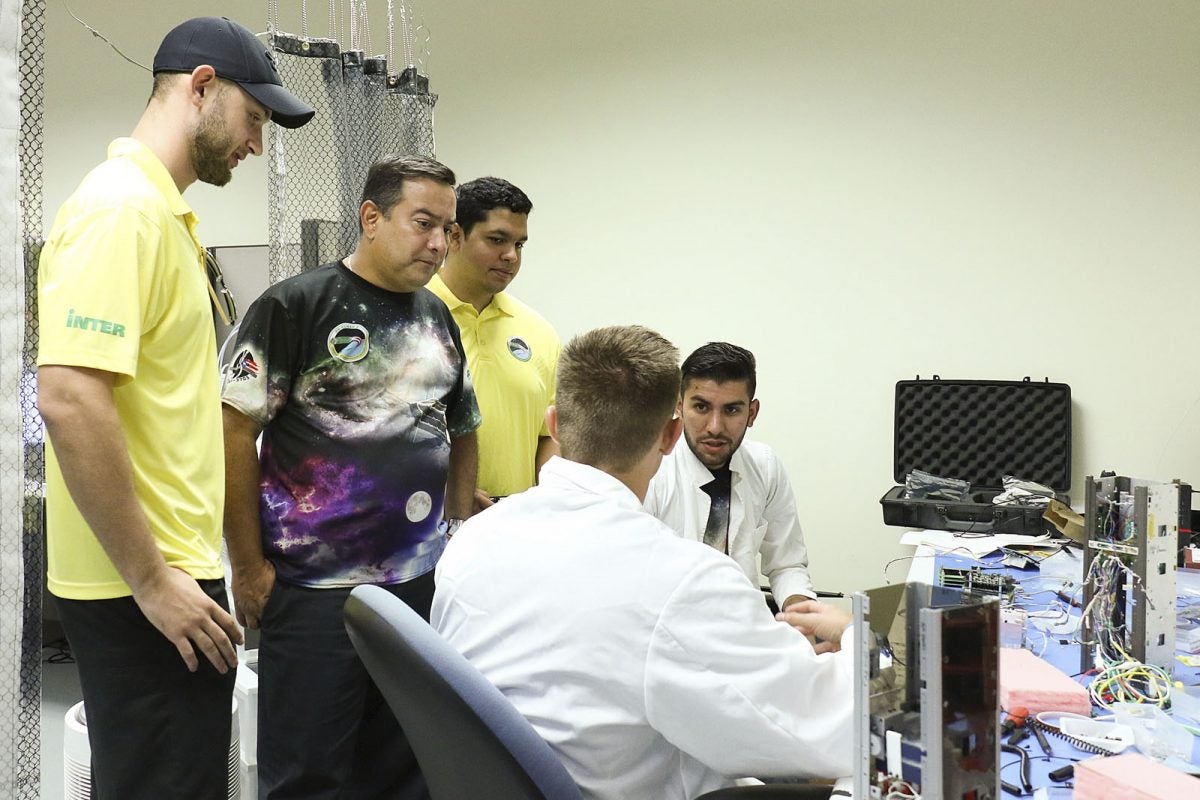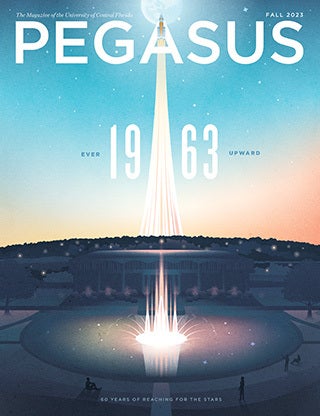Puerto Rico may finally see its first CubeSat launched into space, thanks to a collaboration between the Interamerican University on the island and the Florida Space Institute at the University of Central Florida.
Interamerican aerospace engineering Professor Amilcar Rincon Charris and two of his students visited UCF this week to consult with UCF faculty and students about the construction of the miniature satellite called Puerto Rico CubeSat NanoRocks-2.
“We’ve been wanting to put a CubeSat into space since 2013,” Rincon said. “Now with our partnership with UCF, we are really close.”
Rincon met FSI associate researcher Julie Brisset last year after UCF became the lead organization managing the Arecibo Observatory in Puerto Rico. Brisset has worked on several NASA CubeSats by preparing payloads, such as the NanoRocks project, which flew on the International Space Station for more than a year.
These satellites are compact, no bigger than a bread box. CubeSats, named for their cube shape, house experiments that look at everything from the role of dust in planet formation to determining the best kind of adhesive to use in space. These satellites now launched by private and public companies as well as NASA provide scientists an inexpensive opportunity to conduct experiments in space.
“Our students are building the CubeSat itself, and Julie and her team are building the scientific payload,” Rincon said. “Once we teamed up this way, NASA approved funding as part of the Launch Opportunities program. Now we can really see this happening.”
For the Puerto Rican team, this partnership could mean the island’s first satellite in space, with a target launch date of 2020.
“We’re very excited to see this project succeed and have Puerto Rico’s first satellite in space.”
“It would be historic,” Rincon said. “We are very proud, very excited about that.”
This CubeSat, which will study the role of dust in planet formation, is another example of the kind of growing impact UCF is having in space research, especially when it partners with other groups across the globe. Brisset this week was awarded a NASA grant to fly an experiment aboard a flight from commercial provider Blue Origin. Assistant Professor of physics Adrienne Dove is waiting to see her CubeSat launch from California next week and physics Professor Josh Colwell has another in the final stages of completion.
For Rincon, the project been a long road paved with challenges and opportunities for his students. About 40 students from Interamerican have worked on the project through the years. They include students majoring in mechanical, electrical and computer engineering as well as communications. Many of Rincon’s students have graduated and gone on to work for companies such as Honeywell and Florida Turbine Technologies, which have operations in Puerto Rico. One recent graduate is working at the Kennedy Space Center.
Currently, 15 students are working on the project.
There’s been another bonus for the current students on the project. At least two of them were able to visit Florida for the first time and UCF aerospace engineering major Jacob Kirstein visited Puerto Rico for the first time.
Brisset and Kirstein traveled to Bayamon this summer. They shared lessons learned from UCF’s previous projects. This week Rincon and his students are at UCF to go over design plans and talk about potential challenges in the construction of the new CubeSat.
“This is a great project,” Brisset said. “It’s taking advantage of strengths on both sides. Almicar and his students are working on the vehicle and we are working on the science payload where we have some expertise. The biggest winners are all our students.”
Gabriel Cascante, an electrical engineering major from Interamerican, said he’s “learning how to work in a team, but not just by doing one little part of the project. We’re involved in every part of production and learning to find solutions where there aren’t any you can find in a textbook. It’s been a fabulous experience so far.”
Cascante and classmate Alexander Matta, have been working on the project about five months. The team initially assembled in August 2017 after hearing about Rincon’s project, but Hurricane Maria put a stop to everything, at least for a while.
“It was a major interruption,” Matta said. “We didn’t have electricity, water, nothing. I personally didn’t have light until a few days before New Year’s. Everything kind of stopped. But we’re so glad we’re back on track now. And having the opportunity to come here to exchange ideas has been good.”
Rincon said he builds an environment in his classroom and lab that mimics a company at which students are split into teams and given assignments. This UCF collaboration adds an international dimension to the realistic environment necessary to ensure his students can land jobs after earning their degrees, he said.
“We’ve been very successful,” Rincon said. “And we’re very excited to see this project succeed and have Puerto Rico’s first satellite in space. I can’t wait to see where we go next.”
UCF students are benefitting, too. Students who have worked on previous CubeSat projects have gone onto land jobs with NASA, the agency’s Jet Propulsion Laboratory and many private space companies.
“UCF is in the right place at the right time,” said Colwell. “There’s been big development of private providers and the demand for small satellites is exploding. I think we are very well positioned to ride the wave of opportunities to make an impact in space exploration and to develop new technology.”





